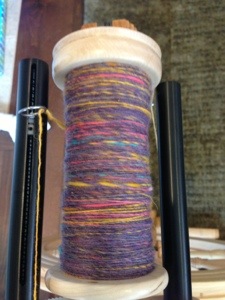Experimental Yarn
/A few weeks ago I decided to dye some wool. I had my soon-to-be-born niece in mind here when I picked the colors. I broke the fiber into pieces to start off with. The majority was in one piece, then 3 much smaller pieces. I decided to go with purple for the main color then teal, pink and yellow for the mix-in colors. I knew that I wanted to try to use my drum carder to blend the colors. Other than that I was completely winging it here.

The dye did not take evenly at all. In fact, there were so many white spots in the purple wool that I dyed it again. To even out the color I decided to try running each color through the drum carder a few times.
Which worked pretty well.
Then it was time to try mixing the colors together. I evenly divided all of the colors into 6 sections and made 6 bats by randomly picking a color and running it through the carder.
Then I randomly chose a bat and started spinning. I was able to fit 3 bats onto 1 bobbin, 3 onto another and then plied them together onto the third bobbin.

Didn't turn out exactly how I expected (although I really didn't have much of an expectation to begin with). I was going for a darker purple and lighter yellow, but too late now. I think it might be ok for a baby jacket or something. We'll see...











